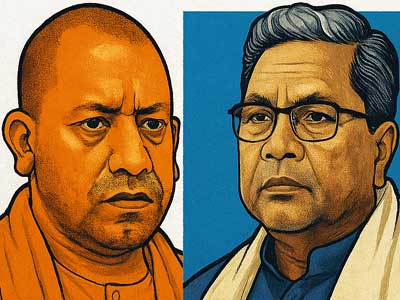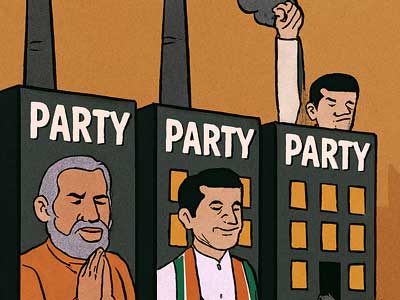On the grand stage of Indian politics, Uttar Pradesh and Karnataka present two starkly different portraits—one riding the wave of Hindutva, with strict and accountable governance, while the other scripts progress with the ink of welfare policies. Recently, when the Union Finance Ministry’s latest report was tabled in Parliament, one phrase dominated conversations: "Karnataka is Number One!"
Yes, Karnataka has now become the state with the highest per capita income in the country—₹2,04,605 per person! This remarkable feat comes after a staggering 93.6 per cent leap over the past decade.
Read in Hindi: योगी का उत्तर प्रदेश बनाम सिद्धारमैया का कर्नाटक
On the other hand, Uttar Pradesh—India’s most populous state—still hovers around a per capita income of ₹1 lakh. Despite the development engine running at full throttle, it hasn’t quite gained full momentum on the tracks, for reasons unknown.
Bengaluru—the heartbeat of Karnataka’s economy—alone contributes 36 per cent of the state’s GSDP, i.e. ₹28.83 lakh crore. Not just that, technology, fintech, and artificial intelligence have collectively turned it into India’s Silicon Valley.
A Mysuru-based industrialist explains, "40 per cent urbanisation, just 3.2 per cent unemployment (2021–22), and an influx of 4.43 million skilled workers make this state not just attractive but also one of the fastest-growing in the country. Where there’s knowledge, capital follows—and Karnataka is a living testament to this."
Meanwhile, commenting on UP, Prof Paras Nath Choudhary says, "It’s easy to get lost in the crowd, but standing out requires something extraordinary. UP is grappling with this very dilemma. Under Yogi Adityanath’s leadership, the state is promoting rapid industrialisation. Factories are lining up in Purvanchal, infrastructure is being prioritised, and groundbreaking ceremonies are being held to lure FDI. Fighter jets land on expressways, defence corridors are being built, and the dazzling Jewar International Airport is nearly ready. Operation Langda has tightened the law's grip. But the burden of population, low urbanisation (22.3 per cent), and poverty rates above 22 per cent pose challenges at every step."
Retired sociologist Babu Gopalakrishnan from Bengaluru notes, "While the Yogi government champions the slogan of a 'Strong Uttar Pradesh’, Siddaramaiah’s Congress is handing out 'Guarantee Cards’. Karnataka’s five guarantee schemes—Gruha Jyoti, Gruha Lakshmi, Shakti, Yuva Nidhi, and Anna Bhagya—have enhanced purchasing power in every village, contributing to a boost in GSDP. Rural poverty has dropped to 24.53 per cent, i.e. below the national average, urban poverty stands at 15.25 per cent, and GST collection has hit ₹1.2 lakh crore (2023–24)."
In contrast, UP’s GST collection is a mere ₹80,000 crore, with a direct tax contribution of around 3-4 per cent. Karnataka doesn’t just have IT—it also boasts mineral wealth, fisheries, and hydroelectric power fueled by heavy rainfall (3,638.5 mm).
Meanwhile, UP’s agriculture relies on the Gangetic plains—sugarcane, wheat, potatoes—but climate crises, deforestation, and the pollution of the Yamuna and Ganga are deteriorating the state’s health.
Karnataka’s unorganised labourers earn a minimum wage of ₹346, while UP’s is ₹383—seemingly higher, but Karnataka still holds an edge when factoring in living standards and inflation.
According to an IT company director, "Bengaluru attracts 44 lakh workers from across India, while 1.23 crore people migrate out of UP in search of jobs—this isn’t just a statistic, it’s a 'brain drain' hollowing out the state’s social fabric."
Karnataka’s Congress-led ‘inclusive politics’ bridges urban educated classes and rural masses—though budget strains and economic disparities between districts remain concerns.
While Karnataka strikes a balance between private sector growth and welfare policies, UP still struggles with basic infrastructure and human development indices.


















Related Items
India stuck in traffic; Cities halt, Horns holler, and time takes a nap
Why fresh blood not entering politics…?
India’s deep dark fraud economy unveiled…